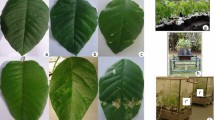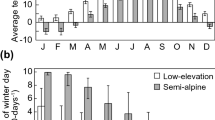Abstract
The volatiles emitted from young and old leaves of two poplar clones (Populus deltoides x maximowiczii, Eridano, and P. x euramericana, I-214) were sampled after exposure to ozone (80 ppb, 5 h d−1, for 10 consecutive days) by solid phase microextraction and characterized by GC-MS. Only mature leaves of the ozone-sensitive Eridano clone developed necrosis in response to ozone exposure, and their membrane integrity was significantly affected by ozone (+86 and +18 % of levels of thiobarbituric acid reactive substances in mature and young leaves). The headspace of the poplar clones studied here contained mono- and sesquiterpenes, both hydrocarbons and oxygenated ones in Eridano, and only hydrocarbons in the clone I-214. Furthermore, some non-terpenes, such as C9-C15 straight-chain aldehydes and C12-C16 saturated and unsaturated aliphatic hydrocarbons, were detected. Other common non-terpene volatiles were oxygenated aliphatic compounds, mainly C6-alcohols and their acetates. Ozone exposure induced a strong change in volatile profiles, depending on clones and leaf age. Regardless of leaf age, in clone I-214, quantities of oxygenated monoterpenes tended to increase after ozone exposure, however, “O3 x leaf age” was not significant. In clone Eridano, increases were observed in emissions of hydrocarbons and oxygenated sesquiterpenes in response to ozone treatment. (Z)-3-Hexen-1-ol and (Z)-3-hexenol acetate were present in traces in the headspace of untreated Eridano mature leaves, but quantities slightly increased after ozone treatment. Quantities of non-terpene oxygenated compounds dropped in the headspace of young leaves of both clones (−24 and −44 % in Eridano and I-214) and also in mature ones of I-214 (−50 %) after ozone exposure. Similarly, quantities of non-terpene hydrocarbons in the emissions from mature leaves of both clones (−58 and −49 %, respectively) decreased, while these compounds increased in young leaves of Eridano (+83 %). We suggest that the resistance of the poplar clone I-214 to O3 is achieved by: i) monoterpenes constitutively present in young leaves and ii) increase of monoterpene content induced by O3 in mature leaves.



Similar content being viewed by others
References
Adams, R. P. 2007. Identification of Essential Oil Components by Gas Chromatography/Mass Spectroscopy, 4th ed. Allured Publishing Corporation, Carol Stream, Illinois, USA.
Apel, K. and Hirt, H. 2004. Reactive oxygen species: Metabolism, oxidative stress, and signal transduction. Annu. Rev. Plant Biol. 55:373–399.
Atkinson, R. 1997. Gas-phase tropospheric chemistry of volatile organic compounds: 1. Alkanes and alkenes. J. Phys. Chem. Ref. Data 26:215–290.
Beauchamp, J., Wisthaler, A., Hansel, A., Kleist, E., Miebach, M., Niinemets, Ǜ., Schurr, U., and Wildt, J. 2005. Ozone induced emissions of biogenic VOC from tobacco: Relationships between ozone uptake and emission of LOX products. Plant Cell Environ. 28:1334–1343.
Biagioni, M., Nali, C., Heimler, D., and Lorenzini, G. 1997. PAL activity and differential ozone sensitivity in tobacco, bean and poplar. J. Phytopathol. 145:533–539.
Blande, J. D., Tiiva, P., Oksanen, E., and Holopainen, J. K. 2007. Emission of herbivore-induced volatile terpenoids from two hybrid aspen (Populus tremula x tremuloides) clones under ambient and elevated ozone concentrations in the field. Global Change Biol. 13:2538–2550.
Calfapietra, C., Fares, S., and Loreto, F. 2009. Volatile organic compounds from Italian vegetation and their interaction with ozone. Environ. Pollut. 157:1478–1486.
Chatfield, C. and Collins, A. J. 1980. Introduction to Multivariate Analysis. Chapman & Hall, London, UK.
Croft, K., Juttner, F., and Slusarenko, A. J. 1993. Volatile products of the lypoxygenase pathway evolved from Phaseolus vulgaris (L.) leaves inoculated with Pseudomonas syringae pv. phaseolicola. Plant Physiol. 101:13–24.
Dunne, R. P. 2010. Synergy or antagonism-interactions between stressors on coral reefs. Coral Reefs 29:145–152.
Duhl, T. R., Helmig, D., and Guenther, A. 2007. Sesquiterpene emissions from vegetation: A review. Biogeosciences 4:3987–4023.
Fares, S., Loreto, F., Kleist, E., and Wildt, J. 2008. Stomatal uptake and stomatal deposition of ozone in isoprene and monoterpene emitting plants. Plant Biol. 10:44–54.
Flamini, G. and Cioni, P. L. 2010. Odour gradients and patterns in volatile emission of different plant parts and developing fruits of grapefruit (Citrus paradisi L.). Food Chem. 120:984–992.
Frost, C. J., Appel, H. M., Carlson, J. E., De Moraes, C. M., Mescher, C., and Schultz, J. C. 2007. Within-plant signalling via volatiles overcomes vascular constraints on system signalling and primes responses against herbivores. Ecol. Lett. 10:490–498.
Guidi, L., Nali, C., Lorenzini, G., Filippi, F., and Soldatini, G. F. 2001. Effect of chronic ozone fumigation on the photosynthetic process of poplar clones showing different sensitivity. Environ. Pollut. 113:245–254.
Hartikainen, K., Nerg, A. M., Kivimäenpää, M., Kontunen-Soppela, S., Mäenpää, M., Oksanen, E., Rousi, M., and Holopainen, T. 2009. Emissions of volatile organic compounds and leaf structural characteristic of European aspen (Populus tremula) grown under elevated ozone and temperature. Tree Physiol. 29:1163–1173.
Heiden, A. C., Hoffmann, T., Kahl, J., Kley, D., Klockow, D., Langebartels, C., Mehlhorn, H., Sandermann Jr., H., Schraudner, M., Schuh, G., and Wildt, J. 1999. Emission of volatile organic compounds from ozone-exposed plants. Ecol. Appl. 9:1160–1167.
Heiden, A. C., Kobel, K., Langebartels, C., Schuh-Thomas, G., and Wildt, J. 2003. Emissions of oxygenated volatile organic compounds from plants Part I: Emissions from lipoxygenase activity. J. Atmos. Chem. 45:143–172.
Joutsensaari, J., LoivÄki, M., Vuorinen, T., Miettinen, P., Nerg, A.-M., Holopainen, J. K., and Laaksonen, A. 2005. Nanoparticle formation by ozonolysis of inducible plant volatiles. Atmos. Chem. Phys. 5:1489–1495.
Kesselmeier, J. and Staudt, M. 1999. Biogenic volatile organic compounds (VOC): an overview on emission, physiology and ecology. J. Atmos. Chem. 33:23–88.
Llusià, J., Peñuelas, J., and Gimeno, B. S. 2002. Seasonal and species-specific response of VOC emissions by Mediterranean woody plant to elevated ozone concentrations. Atmos. Environ. 36:3931–3938.
Loreto, F., Pinelli, P., Manes, F., and Kollist, H. 2004. Impact of ozone on monoterpene emissions and evidences for an isoprene-like antioxidant action of monoterpenes emitted by Quercus ilex (L.) leaves. Tree Physiol. 24:361367.
Loreto, F. and Schnitzler, J.-P. 2010. Abiotic stresses and induced BVOCs. Trends Plant Sci. 15:154–166.
Matsui, K. 2006. Green leaf volatiles: Hydroperoxide lyase pathway of oxylipin metabolism. Curr. Opin. Plant Biol. 9:274–280.
Meroni, M., Picchi, V., Rossini, M., Cogliati, S., Panigada, C., Nali, C., Lorenzini, G., and Colombo, R. 2008. Leaf level early assessment of ozone injuries by passive fluorescence and photochemical reflectance index. Int. J. Remote. Sens. 29:5409–5422.
Nali, C., Guidi, L., Filippi, F., Soldatini, G. F., and Lorenzini, G. 1998. Photosynthesis of two poplar clones contrasting in O3 sensitivity. Trees 12:196–200.
Niinemets, Ü. 2010. Mild versus severe stress and BVOCs: Thresholds, priming and consequences. Trends Plant Sci. 15:145–153.
Pellegrini, E., Francini, A., Lorenzini, G., and Nali, C. 2011. PSII photochemistry and carboxylation efficiency in Liriodendron tulipifera under ozone exposure. Environ. Exp. Bot. 70:217–226.
Peñuelas, J., Llusià, J., and Gimeno, B. S. 1999. Effects of ozone concentrations on biogenic volatile organic compounds emission in the Mediterranean region. Environ. Pollut. 105:17–23.
Pinto, D. M., Blande, J. D., Souza, S. R., Nerg, A. M., and Holopainen, J. K. 2010. Plant volatile organic compounds (VOCs) in ozone (O3) polluted atmospheres: The ecological effects. J. Chem. Ecol. 36:22–34.
Ranieri, A., Giuntini, G., Ferraro, F., Nali, C., Baldan, B., Lorenzini, G., and Soldatini, G. F. 2001. Chronic ozone fumigation induces alterations in thylakoid functionality and composition in two poplar clones. Plant Physiol. Biochem. 39:999–1008.
Rao, M. V., Koch, J. R., and Davis, K. R. 2000. Ozone: a tool for probing programmed cell death in plants. Plant Mol. Biol. 44:345–358.
Rizzo, M., Bernardi, R., Salvini, M., Nali, C., Lorenzini, G., and Durante, M. 2007. Identification of differentially expressed genes induced by ozone stress in sensitive and tolerant poplar hybrids. J. Plant Physiol. 164:945–949.
Röse, U. S. R., Manukian, A., Heath, R. R., and Tumlinson, J. H. 1996. Volatile semiochemicals released from undamaged cotton leaves. Plant Physiol. 111:487–495.
Schnitzler, J.-P., Louis, S., Behnke, K., and Loivamäki, M. 2010. Poplar volatiles—biosynthesis, regulation and (eco) physiology of isoprene and stress-induced isoprenoids. Plant Biol. 12:302–316.
Sharkey, T. D. and Singsaas, E. L. 1995. Why plants emit isoprene. Nature 374:769.
Tani, A., Tozaki, D., Okumura, M., Nozoe, S., and Hirano, T. 2011. Effect of drought stress on isoprene emission from two major Quercus species native to East Asia. Atmos. Environ. 45:6261–6266.
Turlings, T. C. J. 1994. The active role of plants in the foraging successes of entomophagous insects. Norweg. J. Agr. Sci. 16:211–219.
Underwood, A. J. 1997. Experiments in Ecology: Their Logical Design and Interpretation using Analysis of Variance. Cambridge University Press, Cambridge, UK.
Van Reken, T. M., Greenberg, J. P., Harley, P. C., Guenther, A. B., and Smith, J. N. 2006. Direct measurement of particle formation and growth from the oxidation of biogenic emissions. Atmos. Chem. Phys. 6:4403–4413.
Vickers, C. E., Gershenzon, J., Lerdau, M. L., and Loreto, F. 2009. A unified mechanism of action for volatile isoprenoids in plant abiotic stress. Nat. Chem. Biol. 5:283–291.
Vuorinen, T., Nerg, A. M., and Holopainen, J. K. 2004. Ozone exposure triggers the emission of herbivore-induced plant volatiles, but does not disturb tritrophic signalling. Environ. Pollut. 131:305–311.
Vuorinen, T., Nerg, A. M., Vapaavuori, E., and Holopainen, J. K. 2005. Emission of volatile organic compounds from two silver birch (Betula pendula Roth) clones grown under ambient and elevated CO2 and different O3 concentrations. Atmos. Environ. 39:1185–1197.
Zar, J. H. 1984. Biostatistical Analysis. Prentice-Hall, London, UK.
Zini, C. A., Augusto, F., Christensen, E., Smith, B. P., Caramão, E. B., and Pawliszyn, J. 2001. Monitoring biogenic volatile compounds emitted by Eucalyptus citriodora using SPME. Anal. Chem. 73:4729–4735.
Acknowledgements
Thanks are due to the three reviewers for their comments that improved the manuscript.
Author information
Authors and Affiliations
Corresponding author
Electronic supplementary material
Below is the link to the electronic supplementary material.
ESM 1
(DOC 42.5 kb)
Rights and permissions
About this article
Cite this article
Pellegrini, E., Cioni, P.L., Francini, A. et al. Volatiles Emission Patterns in Poplar Clones Varying in Response to Ozone. J Chem Ecol 38, 924–932 (2012). https://doi.org/10.1007/s10886-012-0162-2
Received:
Revised:
Accepted:
Published:
Issue Date:
DOI: https://doi.org/10.1007/s10886-012-0162-2




